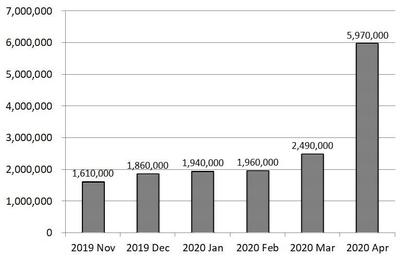Column Finance and the Social Security System 2020.06.24
【Aging, safety net and fiscal crisis in Japan】No.231: The number of workers on leave is increasing rapidly
According to a labor force survey released by the Ministry of Internal Affairs and Communications, the number of workers on leave is increasing rapidly due to the spread of COVID-19 (Figure 1). A worker on leave is defined as a person who has a job, but is not working during the labor force survey week and meets one of the following two categories:
(1) A person who is supposed to receive salaries and wages under an employment contract.
(2) A self-employed person who has a small business that he/she manages and who has not been on leave for more than 30 days consecutively.
Table 1 breaks down the type of work of those on leave. The increase in the number of self-employed workers on leave from 270,000 in March to 700,000 in April reflects the fact that many family run restaurants, cafes, and shops have been forced to refrain from doing business. Regular employees on leave include those who take childcare leave or long-term care leave while receiving part of their salary. However, the sharp increase in the number of regular employees on leave from 890,000 in March to 1,930,000 in April suggests that their employers are in trouble. The increase in the number of part-time employees on leave means that the additional income of housewives who support the household is cut off. We have also heard that students who are unable to afford tuition due to loss of part-time jobs are considering leaving university.
Figure 1 Number of workers on leave
 *Please click the table image to find the original size image.
*Please click the table image to find the original size image. Source: The Ministry of Internal Affairs and Communications
Table 1 Breakdown of workers on leave
 *Please click the table image to find the original size image.
*Please click the table image to find the original size image. Source: The Ministry of Internal Affairs and Communications
